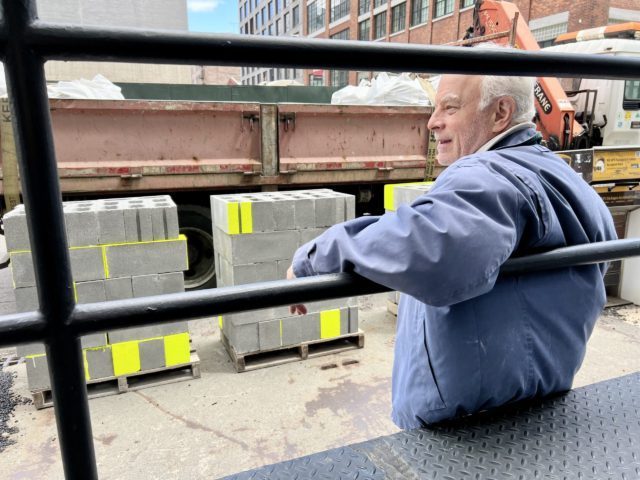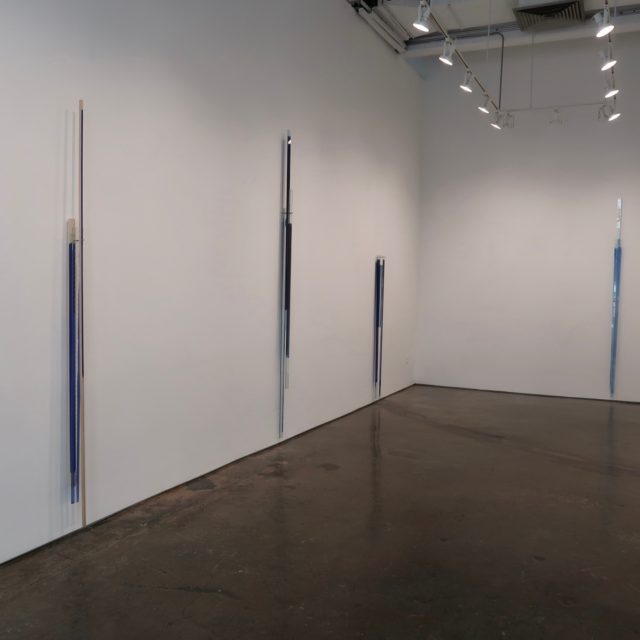
Visual artist Russell Maltz monitors the load out for installation on Jay St. in DUMBO (photo by Matthew Deleget)
RUSSELL MALTZ: PAINTED / STACKED / SITE
Minus Space
16 Main St., Suite A, Brooklyn
Saturdays through July 30, free, 11:00 am – 5:00 pm
www.minusspace.com
www.russellmaltz.com
When I first arrived at Minus Space in DUMBO to see “Russell Maltz: Painted / Stacked / Site,” I thought that the final phase of the Brooklyn-born visual artist’s multipart four-month retrospective had spilled out of the gallery and into the street. Since the mid-1970s, Maltz has been creating works using a wide range of materials, from concrete cinder blocks, glass, and pegboards to found wood panels, PVC pipes, paper, and a swimming pool; he has collaborated with construction companies, and he enjoys photographing artlike industrial detritus. There’s a lot of construction going on outside the gallery, some of which evoked Maltz’s use of color and materials.
Minus Space first showed his “POOL” project beginning in April, followed by “Stacks,” and now concludes with “Needles,” consisting of long, narrow vertical works of acrylic and polyurethane on glass plate and wood, suspended from a galvanized nail, each at a different height on the wall, forming three-dimensional palimpsests. Depending on where the viewer stands, they’ll experience varying depth of space in the works, including reflections of what is happening on Main St. — in this case, bringing the outside construction inside. In the main gallery each piece is a shade of blue, creating unique shadows on the walls. (There are additional works in other colors in the office.)
In conjunction with the exhibit, Maltz put up a temporary installation in a storefront at 28 Jay St., and his Scatter sculpture is part of a group show in Hillman Garden at 100 Broome St. in Luther Gulick Park this summer.
Maltz is a relaxed, easygoing guy who loves discussing art; below he talks about color, material, Brooklyn, and working during the pandemic.
twi-ny: You’re a Brooklyn boy, like me.
russell maltz: Yes, I am.
twi-ny: What do you think about how Brooklyn has changed over the years? I can’t imagine a place like Minus Space existing when I was a kid.
rm: I was born in Brownsville. My family moved to Canarsie when I was two or three years old. We lived in the Bay View Housing Project down by the Belt Parkway alongside Jamaica Bay.
twi-ny: I was born in Flatbush.
rm: Many different types of people lived [in Canarsie], mostly working class and from many ethnic and religious backgrounds. I’ve always regarded Brooklyn as a place where there is an ever-changing community of people. I think that the essence of any community and its value is all about the neighborhood. It seems that what is changing and what is inevitable is that in many places the need for development and the changes to a neighborhood that the development brings has priced out many of its current and historic residents from living in that particular neighborhood — the folks who made it what it is. Development should enrich a neighborhood and should be community-based so that the people who live there can continue to contribute to its identity and culture.
twi-ny: I couldn’t agree more. Since April, Minus Space has been showing a retrospective of your career in different phases, going back five decades. What has it been like putting together each individual section? Were you flooded with memories?
rm: Always — although, there was a prequel to the Minus Space exhibition in 2017 at the Stadtgalerie Saarbrücken in Saarbrücken, Germany, that was accompanied by a monograph that covered work from 1976 through 2017. The work shown in Saarbrücken was mostly done in Europe during these years. The Minus Space show gave me the opportunity to build from the Saarbrücken show in that [Minus Space owner] Matthew Deleget and I decided to make this show in three phases. Each phase would represent a different period of my work and identify the common threads within the work that continue to identify the work to present.
The “POOL” project (1976–79) explored the origins of my ideas and philosophies, the “Stacked” works (1983–2022) explored works made as sites and examined how color transforms material, and the third phase, “Needles” (2018–22), explores my concerns with painting on glass. Combined with other simultaneous activities, such as at 28 Jay St., the installation of construction materials in a vacant storefront, and the “Yardbirds” installation at the Hillman Houses on the Lower East Side, painted wooden elements used by gardeners in their everyday gardening activities. All of these venues gave me a chance to exhibit the many forms that my work can take and elevate the question of what a painting can be.
twi-ny: How did Scatter come about?
rm: The Hillman Garden came about as an invitation from a good friend, the artist David Goodman. David along with sculptor Bruce Ostler invited several artists to install their work in the garden. A garden to me exudes the energy of change: changing seasons, changing growth, and changing habit. I decided to do a work that comprised numerous wooden stakes used by the gardeners (mostly people who live at the Hillman Houses) to stabilize the trees. I painted the stakes Day-Glo yellow. It started in early April as a pile of painted material leaning against the garden shed and was transformed, evolving into a work that was scattered and used by the gardeners for its original purpose. The yellow color enhanced the daffodils, complemented the daylilies, and spread a smattering of color throughout the garden in a natural and random way, creating yet another way to see a painting.

“Russell Maltz: Painted / Stacked / Site” continues Saturdays through July 30 at Minus Space in DUMBO (photo by twi-ny/mdr)
twi-ny: This month at Minus Space you’re showing your more recent fragile “Needles.” What were some of the main considerations when hanging the show?
rm: The “Needle” works began in 2013. I had been developing a series of works using glass because of my ongoing explorations with transparency. For this phase of the exhibition I wanted to install the most recent pieces on glass and give the work the space to breathe to establish a presence in the site and give the viewer time to experience each work as a unique one.
twi-ny: How do you decide what materials to work with?
rm: The “Needles” are a result of a serendipitous event that occurred while working in my studio. I was cutting long lengths of plywood for another piece I was working on. When the cutting was complete and as I was doing my cleanup, I saw a bunch of sawn-off strips lying in a pile on the floor; the results of one action can be the beginnings of another action — and — Aha! Well, the rest and what was to follow came quickly in that these long narrow strips evolved into the exploration of color, form, and presence with various materials in yet another way to make a painting.
twi-ny: Your use of color is striking, particularly bright yellow and green and bold red. In a recent Minus Space talk, you said that “color is the glue that holds it all together.” What comes first — material or color, and how do they come together for you?
rm: Most, if not all of my inspirations and ideas about what I make, come from everyday life, both locally and when I travel. This is a great question because the answer is not always identifiable for me, in that the order of a thing that is inspirational or evokes me into the process of making has a sequence. However, if there is one thing that might be identifiable, it would most likely be light. It is the light that is the identifier to action, and the color that is the glue that transforms and holds the work in place.
twi-ny: The show also features two red stacks (ACCU-FLO Bundled #1 & #2) in the side window that are visible to passersby. There’s a lot of construction going on in the street, so it makes for a fascinating juxtaposition. You were a carpenter and a house painter, but I can imagine your having been a construction engineer in a previous life. Do construction sites really get your juices flowing?
rm: Yes. Not so much in that the sites are there but in the sheer energy of focus, coordination, and human power and coordination that it takes to engage in the process of making.
twi-ny: How did the pandemic lockdown affect your work? Were you able to spend productive time at your Crosby St. studio, or was creating difficult?
rm: I was in New York City for the entire run of the pandemic. It was for me one of the most productive times I can remember. It gave me the time I needed to do what I want and love most to do . . . the work.